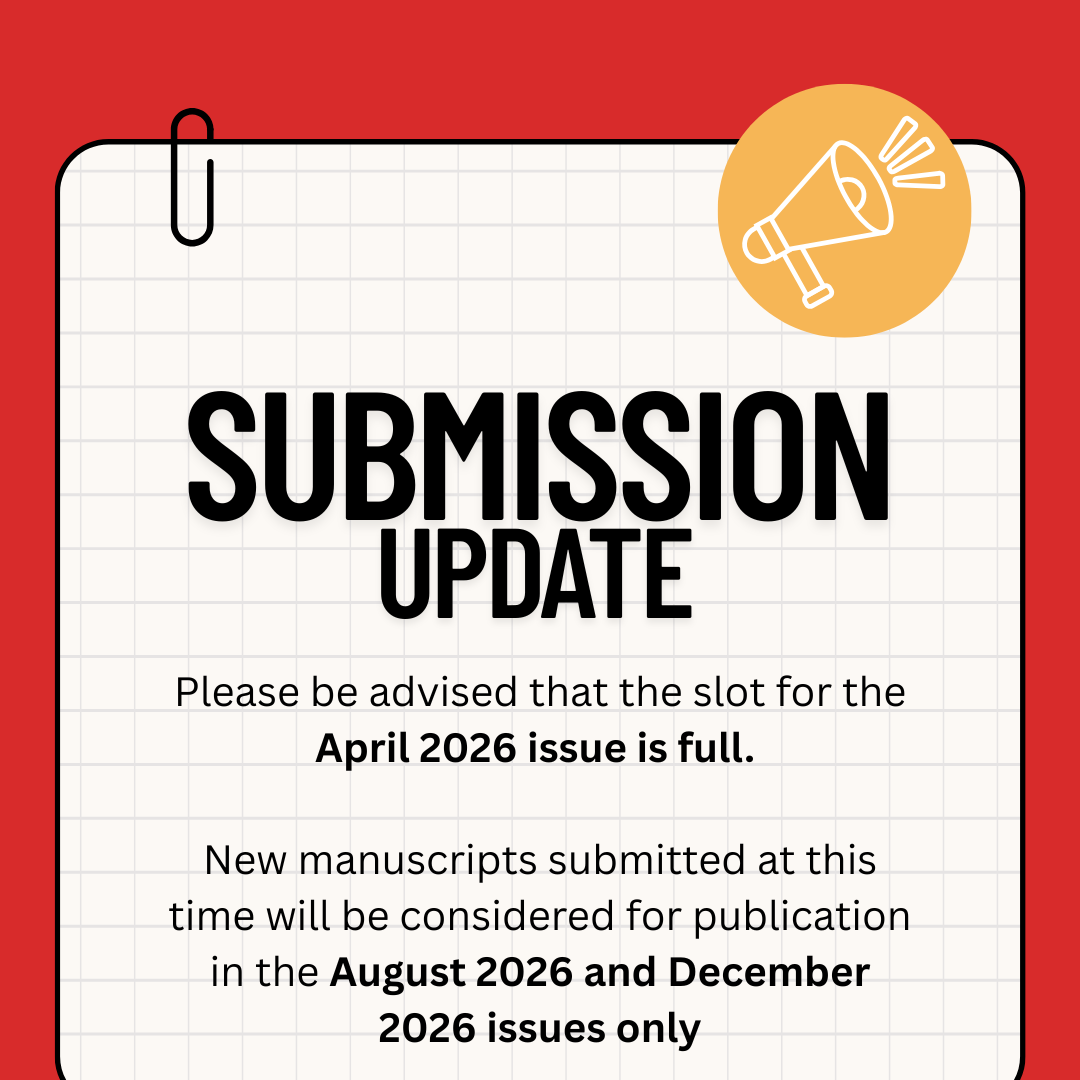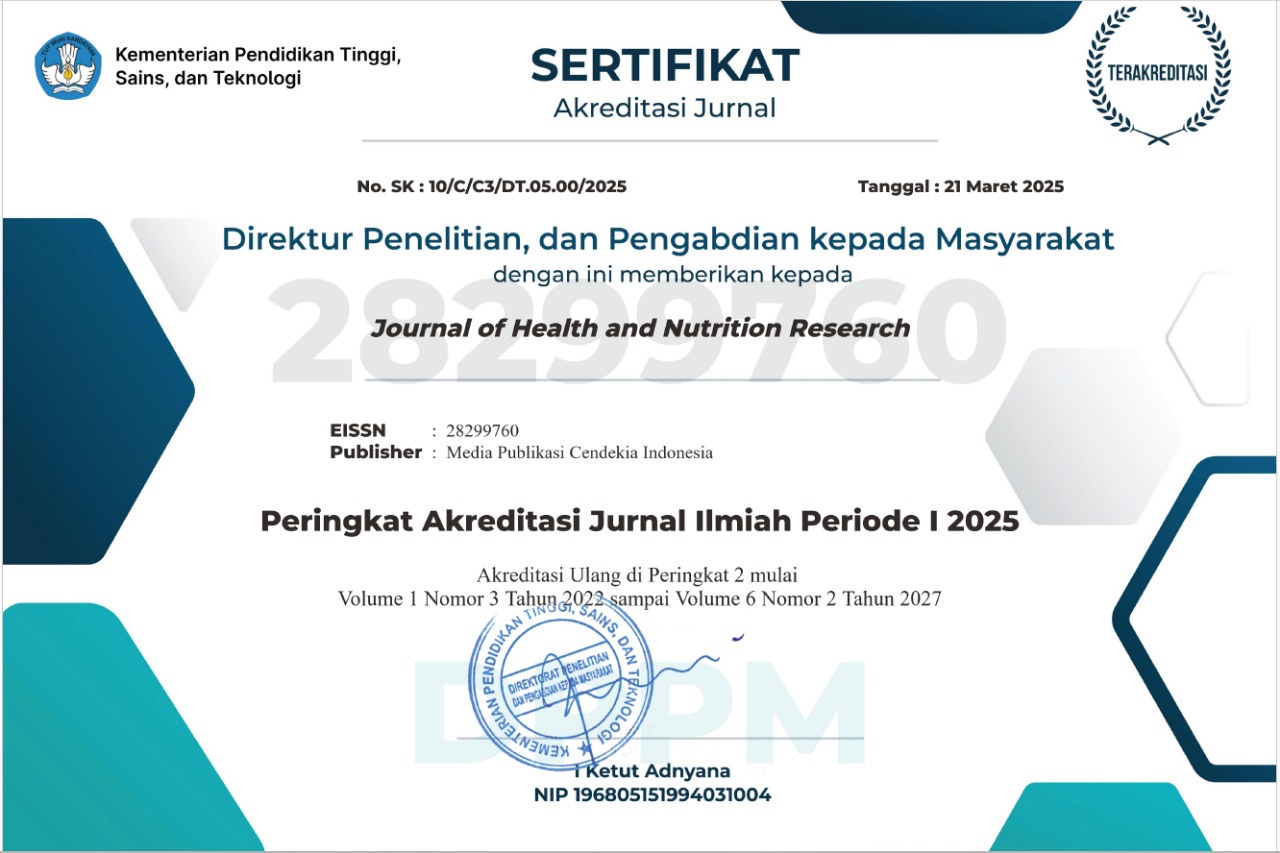Relationship Between Economic Status, Infectious Diseases and Urinary Iodine Excretion with Stunting Incidence of Elementary School Children in IDD Endemic Areas, Enrekang Regency
Keywords:
Stunting, School children, Family Economics, Infectious Diseases, UIEAbstract
This study aimed to determine the relationship of economic status, infectious diseases, and Urinary Iodine Excretion (UIE) with the incidence of stunting in elementary school children in IDD endemic areas, Enrekang Regency. This research was an observational analytic study with a cross-sectional approach. Subjects in this study were taken by purposive sampling as many as 100 children aged 6-12 years. Research data were collected using a questionnaire, microtoise, and UIE Lab Test and then processed using the chi-square test. The results showed that the proportion of stunting was 72.2% and normal was 28.0%, the low family economy was 82.0%, infectious disease was 79.0%, and low urinary iodine deficiency was 21.0%. The chi-square test showed that there was a significant relationship between economic status (p=0.045) and infectious diseases (p=0.012) with the incidence of stunting, but there was no relationship between UIE and stunting (p=1,000). The economic status of parents and a history of infectious diseases contribute to the incidence of stunting. Modification of parents' crops by harvesting crops in a short time is recommended to increase family income and increasing children's healthy and clean behaviour is considered necessary to prevent infectious diseases.
Downloads
References
Argente J. Challenges in the Management of Short Stature. Horm Res Paediatr. 2016;85(1):2–10.
Mattei D, Cavarzere P, Gaudino R, Antoniazzi F, Piacentini G. DYSMORPHIC features and adult short stature: possible clinical markers of KBG syndrome. Ital J Pediatr. 2021 Dec;47(1):15.
WHO. Levels and trends in child malnutrition: UNICEF/WHO/The World Bank Group joint child malnutrition estimates: key findings of the 2020 edition [Internet]. 2020 [cited 2022 Nov 29]. Available from: https://www.who.int/publications/i/item/9789240003576
Kemenkes RI. Riset Kesehatan Dasar (Riskesdas). Jakarta: Badan Penelitian dan Pengembangan Kesehatan Kementerian Kesehatan RI; 2018.
Torlesse H, Cronin AA, Sebayang SK, Nandy R. Determinants of stunting in Indonesian children: evidence from a cross-sectional survey indicate a prominent role for the water, sanitation and hygiene sector in stunting reduction. BMC Public Health. 2016 Jul 29;16(1):669.
Kumar Dey A, Bhusan Nath A. Nutritional Status of School Going Children (6-15 Years) in a Semi-Urban Area of Cachar District, Assam. jemds. 2017 Jul 6;6(54):4057–62.
Rahaman SN, Das S, Dash SK, Giri B, Ali KM. Nutritional Status of Primary School Children in Different Parts of India: A Review. IJCRR. 2019;11(07):01–4.
Beal T, Tumilowicz A, Sutrisna A, Izwardy D, Neufeld LM. A review of child stunting determinants in INDONESIA. Matern Child Nutr. 2018 Oct;14(4):e12617.
Ryadinency R, N S, Patmawati TA. Analysis of Determinant Factors in Stunting Children in Palopo, Indonesia. JWH. 2020 Dec 17;1(2):77–82.
Muche A, Dewau R. Severe stunting and its associated factors among children aged 6-59 months in Ethiopia; multilevel ordinal logistic regression model. Ital J Pediatr. 2021 Jul 26;47(1):161.
Ali NB, Tahsina T, Hoque DME, Hasan MM, Iqbal A, Huda TM, et al. Association of food security and other socio-economic factors with dietary diversity and nutritional statuses of children aged 6-59 months in rural Bangladesh. PLoS One. 2019;14(8):e0221929.
Webb CM, Morales ML, Lopez M, Baca-Turpo B, Arque E, White AC, et al. Stunting in pre-school and school-age children in the Peruvian highlands and its association with Fasciola infection and demographic factors. Siles-Lucas M, editor. PLoS Negl Trop Dis. 2021 Jun 21;15(6):e0009519.
Wicaksono F, Harsanti T. Determinants of Stunted Children in Indonesia: A Multilevel Analysis at the Individual, Household, and Community Levels. Kesmas: National Public Health Journal. 2020 Feb 1;15(1):48.
Mahmudiono T, Nindya T, Andrias D, Megatsari H, Rosenkranz R. Household Food Insecurity as a Predictor of Stunted Children and Overweight/Obese Mothers (SCOWT) in Urban Indonesia. Nutrients. 2018 Apr 26;10(5):535.
Mutiarasari D, Miranti M, Fitriana Y, Pakaya D, Sari P, Bohari B, et al. A Determinant Analysis of Stunting Prevalence on Under 5-Year-Old Children to Establish Stunting Management Policy. Open Access Maced J Med Sci. 2021 Jan 19;9(B):79–84.
Nurhayati E, Paramashanti BA, Astiti D, Aji AS. Dietary diversity, vitamin D intake and childhood stunting: a case-control study in Bantul, Indonesia. Mal J Nutr. 2020 Aug 5;26(2):273–87.
Mediani HS. Predictors of Stunting Among Children Under Five Year of Age in Indonesia: A Scoping Review. GJHS. 2020 Jun 8;12(8):83.
Julianti E, Elni E. Determinants of Stunting in Children Aged 12-59 Months. Nurs Med J Nursing. 2020 Apr 27;10(1):36–45.
Hendraswari CA, Purnamaningrum YE, Maryani T, Widyastuti Y, Harith S. The Determinants of Stunting in 24-59 Month-Old Children in Kulon Progo District 2019. Kesmas: National Public Health Journal [Internet]. 2021 May 1 [cited 2022 Nov 29];16(2). Available from: http://journal.fkm.ui.ac.id/kesmas/article/view/3305
Sulistyaningsih DA, Panunggal B, Murbawani EA. Iodine Urinary Status and Iodine Intake in 12-24 Months Stunting Children. Media Gizi Mikro Indonesia. 2018 Dec 27;9(2):73–82.
Zimmermann MB, Andersson M. GLOBAL ENDOCRINOLOGY: Global perspectives in endocrinology: coverage of iodized salt programs and iodine status in 2020. Eur J Endocrinol. 2021 Jun 10;185(1):R13–21.
Thomassen RA, Kvammen JA, Eskerud MB, Júlíusson PB, Henriksen C, Rugtveit J. Iodine Status and Growth In 0–2-Year-Old Infants With Cow’s Milk Protein Allergy. Journal of Pediatric Gastroenterology & Nutrition. 2017 May;64(5):806–11.
Bhattacharyya H, Nath CK, Pala S, Medhi GK, Chutia H. Iodine Deficiency Disorders in Children in East Khasi Hills District of Meghalaya, India. Indian Pediatr. 2020 Sep;57(9):811–4.
Abbag FI, Abu-Eshy SA, Mahfouz AA, Alsaleem MA, Alsaleem SA, Patel AA, et al. Iodine Deficiency Disorders as a Predictor of Stunting among Primary School Children in the Aseer Region, Southwestern Saudi Arabia. IJERPH. 2021 Jul 18;18(14):7644.
Elias E, Tsegaye W, Stoecker BJ, Gebreegziabher T. Excessive intake of iodine and low prevalence of goiter in school age children five years after implementation of national salt iodization in Shebedino woreda, southern Ethiopia. BMC Public Health. 2021 Dec;21(1):165.
Published
How to Cite
Issue
Section
Copyright (c) 2022 Nur Abri, Abdul Razak Thaha, Nurhaedar Jafar

This work is licensed under a Creative Commons Attribution-NonCommercial-ShareAlike 4.0 International License.
Most read articles by the same author(s)
- Sitti Zakiah, Aminah Toaha, Nur Abri, Endah Wahyutri, The Effect of Nutrition Education on Knowledge, Attitudes, and Iron Intake in Adolescent Girls , Journal of Health and Nutrition Research: Vol. 2 No. 3 (2023)
- Nur Abri, Identification of Socio-Demographic Factors with the Incidence of Stunting in Elementary School Children in Rural Enrekang , Journal of Health and Nutrition Research: Vol. 1 No. 2 (2022)
- Saibatul Hairiyah, Aminah Toaha, Nur Abri, Dini Indo Virawati, The Effect of SEKAR (Sumber Edukasi Anemia yang Relevan) Card-Based Nutrition Education on Knowledge and Iron Intake in Pregnant Women , Journal of Health and Nutrition Research: Vol. 2 No. 3 (2023)
- Nur Abri, Nur Zakiah, Alya Fajrani Risal, The Relationship Between Early Pregnancy, Birth Distance, and Resident Status with Stunting Incidence in Elementary School Children In Enrekang Rural , Journal of Health and Nutrition Research: Vol. 2 No. 2 (2023)



















